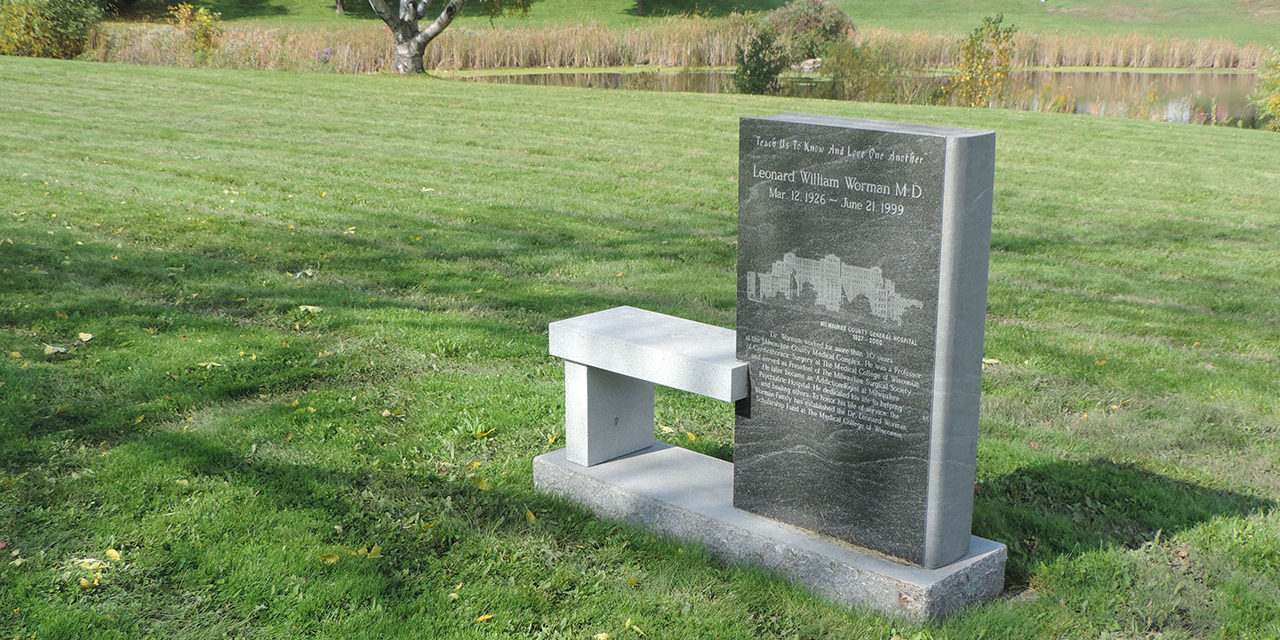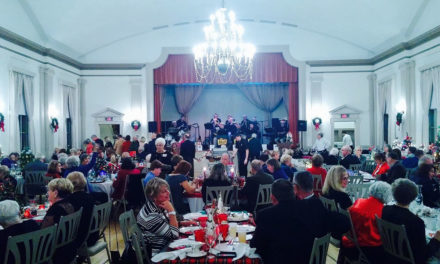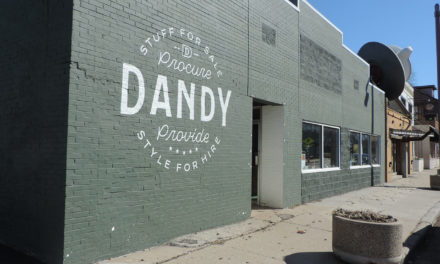While the Milwaukee County grounds have entered a new era in healthcare, research and residential options, a portion of its unearthed past poses new questions about our humanity.
By Rick Romano
A long stretch of grassy, rolling lawn carpets the southern border of the Milwaukee Regional Medical Center between Wisconsin Avenue and a meandering creek connecting several ponds. There, amid the occasional bushes and trees strewn along the expanse, is a cement bench attached to a two-sided memorial stone marker.
On one side, the marker recognizes the accomplishments of Leonard William Worman, M.D., for his contributions as a cardiothoracic surgeon and in psychiatric medicine. It also notes the creation of a College of Medicine scholarship fund in his name. On the other side, Dr. Worman’s wife, Georginne, is recognized for her life’s work as a local librarian and notes both bodies were donated to the Medical College of Wisconsin for study to further “the ongoing pursuit of knowledge.” The attached bench provides a convenient place to sit and learn about the two honored individuals.
The shining memorial stands elegantly in stark contrast to thousands of other individuals who are unceremoniously buried nearby. Most of their names and lives – a window into local history and the struggle to settle and survive in a new country – are not featured and will never be known except in a general sense. In fact, many of those remains have been discovered and unearthed in the name of progress. A good portion of those bodies now serve educational and research purposes at UW-Milwaukee.
Begging questions
These facts accentuate the divide between the “haves and have-nots” among those who came to Milwaukee from Europe during the late 1800s through the early 1900s. It is not only a story about their lot in life once they arrived but also about how we addressed physical and mental illnesses, how we addressed end-of-life concerns, and how we now look back and consider the future.
There are advocates on all sides of the question of whether the remains should continue to be studied for years to come or whether they should be returned to the place they were found. No less important is the question of how they should be better recognized as a population that belongs to local history.
For restoring and memorializing
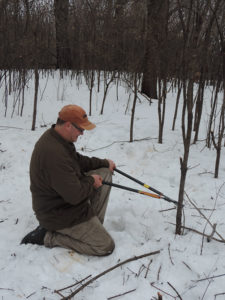 Michael McBride, M.D., a psychiatrist affiliated with Froedtert and Zablocki VA Medical Center, and Jonathan Piel, an amateur historian who also is a marketing professional for a local tech company, have raised the issue of restoration. Beyond appealing to county, state and educational authorities, they are hands-on in conducting tours of recognized gravesites north of Watertown Plank Road, and even helping maintain nearby Sanctuary Woods, culling overgrown buckthorn to help preserve the natural resource.
Michael McBride, M.D., a psychiatrist affiliated with Froedtert and Zablocki VA Medical Center, and Jonathan Piel, an amateur historian who also is a marketing professional for a local tech company, have raised the issue of restoration. Beyond appealing to county, state and educational authorities, they are hands-on in conducting tours of recognized gravesites north of Watertown Plank Road, and even helping maintain nearby Sanctuary Woods, culling overgrown buckthorn to help preserve the natural resource.
McBride and Piel said the occasional tours of those intact graveyards has helped open the eyes of many local residents and first-time visitors to the grounds.
“They were stunned by the beauty of the woods and the history that is there,” McBride said.
Over the years, McBride, Piel and others have appealed to many in an effort to recognize historical importance of the place, to no avail.
“We pitched to Froedtert to memorialize the dead,” said McBride, who noted that medical center officials once invited him to learn more about plans to build a new surgical center that would be built on newly discovered burial grounds that would require removal of those remains. “I even used Froedtert’s mission statement of how they reach out to serve the poor.”
For McBride and Piel, the recognition is about remembering honoring those who lived before us.
“These are the people who came here from other countries to find a better life,” McBride said. “They are us.”
Past, current and future status
Well-placed officials – including Froedtert spokesperson Kathy Seija, Teig Whaley-Smith, Milwaukee County’s director of administrative service, County Supervisor Luigi Schmitt, and Leslie Eisenberg, burial site program coordinator at the Wisconsin State Historical Society – all said there are no plans to recognize the burial grounds south of Watertown Plank Road.
Also included, are the hundreds of remains beneath a tree-lined swath of tree-lined land at the southeast corner of the grounds, just north of Wisconsin Avenue, east of 87th Street and tucked in along Windsor Court, a few feet from residences.
The path from discovering buried remains to transferring those findings to research labs has been dictated by state statute. It gives the Wisconsin State Historical Society authority to decide what happens after remains are unearthed. In the case of the County Grounds, near where Froedtert has been constructed and expanded over the years, it was ruled that the discovered remains were to be excavated by the Great Lakes Archeological Society and eventually go to Marquette University in the early 1990s. By 2013, the state worked with UW-Milwaukee to continue research findings.
Researchers from both institutions weighed in on the work
Norman Sullivan, a retired Marquette professor who led the initial investigation, said the work was hampered by lack of resources.
“There was a little bit of funding from the county,” he said, “but I was doing this primarily on my own for 10 years. It was a tough slog.”
While Sullivan managed to complete multiple dissertations from the research, he said the required data gathering, an aborted teaming-up with an aggressive researcher from Loyola University of Chicago and the expressed interest from UW-Milwaukee to take on the project all wore on him.
“It was a sore point with me,” Sullivan said. “Once data were available, I thought it might be possible to look through the death records from the City of Milwaukee and County and match the remains with specific individuals.”
“It all produced some ill will and, in the end, I was happy to get out of it.”
Though he is no longer part of the project, Sullivan reviews his past research in his retirement.
Researcher’s project philosophy
By 2008, UWM was granted the project. The university’s Patricia Richards, a senior scientist and anthropology professor, leads the Milwaukee County Poor Farm Cemetery Project. Richards said the effort to study the remains of more than 1600 bodies most likely will continue long after she retires from what is already a decades-long career.
“I know some people are against this project for a variety of reasons and it is always difficult to characterize one’s feelings about the dead,” Richards said. “In my particular perspective, I have spent my career studying living populations and the dead and their relationship is interesting. It’s always a sense of us, our ancestors and who we are as a community and that’s why it gets emotional.
“The County grounds site is interesting,” she said, “because the buried’s relationship with the community was already fraught. These were folks who did not have relatives to bury them, they were unidentified individuals from the coroner’s office, and they were individuals who not have the safety net where they could normally be buried. This is what identifies and characterizes them.”
What They Tell Us
The remains of the men, women and children who have been unearthed and studied have provided teachable moments to anthropology students as well as a body of knowledge about the culture of late 19th and early 20th century Wisconsin.
Retired Marquette professor and past cemetery researcher Norman Sullivan and current cemetery project leader Patricia Sullivan of UW-Milwaukee noted study results.
 Richards estimates that 50 students who have graduated worked on the cemetery project over the years and currently there are six Ph.D. and six master’s candidates exposed to the same program. She said the study has provided a valuable base of knowledge for those entering anthropology-related careers.
Richards estimates that 50 students who have graduated worked on the cemetery project over the years and currently there are six Ph.D. and six master’s candidates exposed to the same program. She said the study has provided a valuable base of knowledge for those entering anthropology-related careers.
Sullivan and Richards also note the work has been valuable from a community health perspective.
“Different things needed to be examined,” Sullivan said. “Joint surfaces for arthritis and other things such as broken bones needed to be categorized and coded in a certain way.”
Richards said the study has resulted in a better understanding of the population’s lifestyle.
“It’s a scientific way of understanding the way in which one’s social and economic situation impacts the skeleton,” she said, noting that many male lifestyles can be pieced together through traumas and diseases.
“A lot of that trauma came from not taking care of themselves, getting into fights, doing heavy labor and there was a significant amount of disease including tuberculosis, syphilis, and those associated with a lack of nutrition.”
The value of this information is important because it accentuates the significance of access to health care.
“The effects of arthritis and bone trauma on an individual’s gait is important,” Richards said. “If you have access to health care, you take care of it and you go on. During this era, this was not done. The wounds were not cleaned, and people could not stop working, they didn’t have access to food, so these wounds improperly healed and people often died.”
Women and children also suffered in situations such as lack of health care access during pregnancy and childbirth.
“Many will say we have moved beyond that,” she said, “but in the City of Milwaukee we still have an appalling rate of infant mortality, so some things haven’t gotten better.”
Richards has one significant takeaway from her studies.
“It has reinforced the idea that human beings are more than their broken bones or their disease or what winds-up in their coffins,” she said. “The resilience can be traced. It’s a gift to be able to do it. It’s both encouraging and discouraging to discover that.”
Will They Be Reburied?
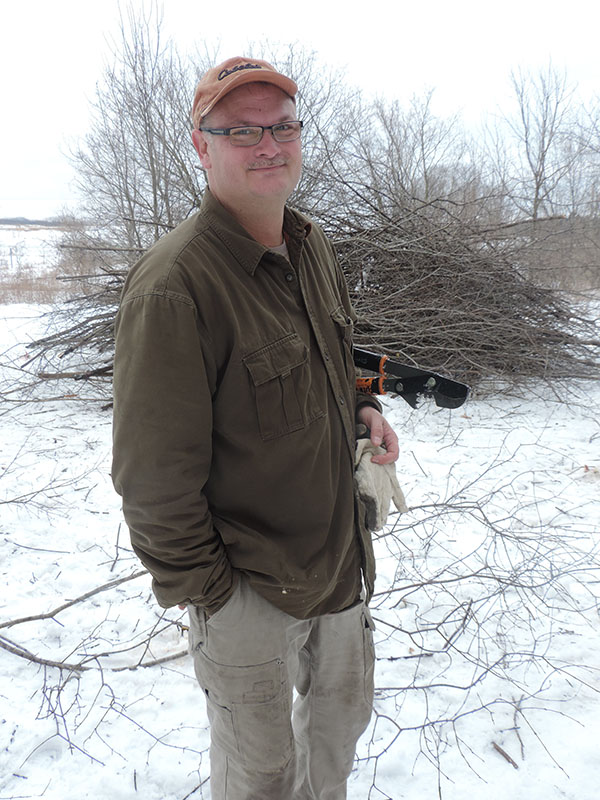 This ultimate question is still pondered by researchers and burial advocates.
This ultimate question is still pondered by researchers and burial advocates.
Richards said she is not against reburial, though she notes that research could go on for a number of years. Also, Froedtert has no say since it is a tenant of Milwaukee County and future development may prevent that option in that location. She also pointed to Europe, where burial remains are regularly unearthed after a few decades to make room for more cemetery needs.
Grave advocates, including psychiatrist Michael McBride and amateur historian Jonathan Piel, ideally want the remains to be reburied and identified to the furthest possible extent in case heirs can connect to them.
Piel has written about these ideals, noting that inconvenience or the uncomfortable specter of graves near a healing place like a medical center should not deter recognition.
“While this may explain motivation,” he wrote, “it should not excuse our moral obligation to recognize and honor the interred deceased which in any other location would be marked and treated as hallowed ground.”

